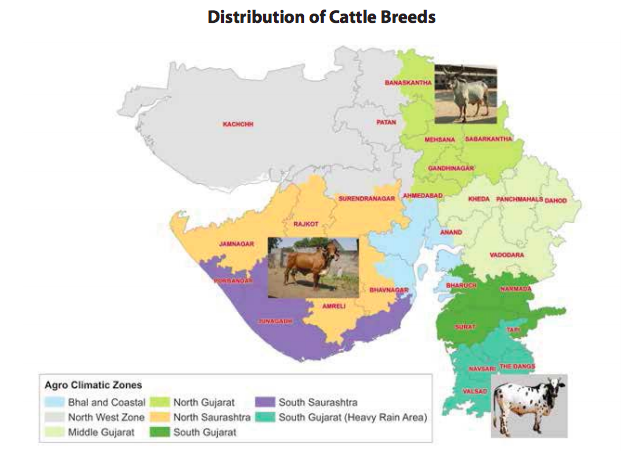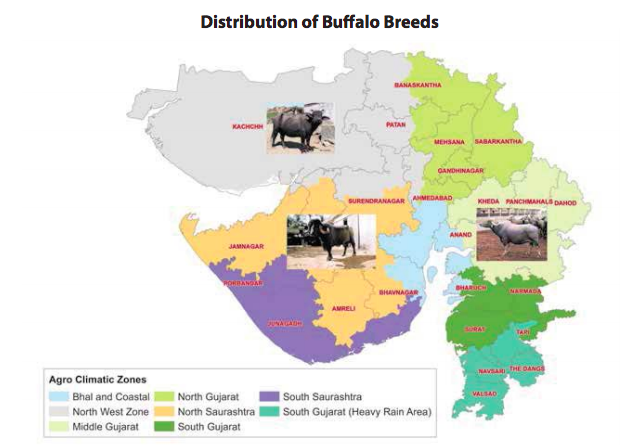Overall India has a total of 137 breeds of domesticated animals, of which about 18 breeds, including some internationally recognised ones, are available in Gujarat. The State has high-quality, high-yielding breeds of cattle and buffaloes. The Gir and Kankrej breeds of cows and Jaffarabadi, Mehsana, and Surti breeds of buffaloes are well known for their high milk-yield capacity and constitute a valuable genetic resource. With the recognition of the Banni breed by the National Bureau of Animal Genetic Resources (NBAGR), Gujarat is now proud home to four major buffalo breeds of the total 12 recognised breeds in India.
Distribution of Gujarat’s Cattle Breeds

Gyr/Gir cattle
The Gir or Gyr is one of the principal Zebu breeds originating in India. It has been used locally in the improvement of other breeds including the Red Sindhi and the Sahiwal. It was also one of the breeds used in the development of the Brahman breed in North America. In Brazil and other South American countries the Gir is used frequently because, as a Bos indicus breed, it is resistant to hot temperatures and tropical diseases. It is well known for its milk-producing qualities and is often bred with Friesian cows to make the Girolando breed.
The Gir is distinctive in appearance, typically having a rounded and domed forehead (being the only ultra convex breed in the world), long pendulous ears and horns which spiral out and back. Gir is generally mottled with the colour ranging from red through yellow to white, black being the only unacceptable colour. They originated in southwest India in the state of Gujarat and have since spread to neighbouring Maharashtra and Rajasthan.
Cows average 385 kg in weight and 130 cm in height; bulls weigh 545 kg on average, with a height of 140 cm. At birth, calves weigh about 20 kg. The average milk yield for the Gir is 1590 kg per lactation, with a record production of 3182 kg at 4.5% fat in India. In Brazil, they average 3500 kg per lactation, with a world record production of 17 120 kg by the cow Profana de Brasília.
Kankrej cattle
The Kankrej is an Indian breed of zebuine cattle. It originates from the arid region of the Rann of Kutch in the state of Gujarat, and in neighbouring Rajasthan. Under the name Kankaraj, it is also present in Tharparkar District, in Sindh, Pakistan. It is also known by the names Bannai, Nagar, Talabda, Vaghiyar, Wagad, Waged, Vadhiyar, Wadhiar, Wadhir and Wadial. It is a dual-purpose breed, used both for draught work and for milk production.
From about 1870 onwards, Kankrej bulls and cows were exported to Brazil, where they were used to create the Guzerá breed, which was later among the breeds from which the American Brahman developed.
The last official census data for the Kankrej population in India dates from 1977 when there were 465 000. 215 In Pakistan, the population was recorded in 2006 at 273 000.
Dangi cattle
Dangi is an indigenous cattle breed of India. It originated in the hilly tracts of Dangs comprising the Nasik and Ahmednagar districts in the state of Maharashtra. The breed is medium to large in body size. They are a very good draught breed and known for their adaptability to heavy rainfall areas. The skin of this breed secretes an oil element that enables them to tolerate heavy rains.
Distribution of Gujarat’s Buffalo Breeds

Jafarabadi buffalo
Jafarabadi buffalo is a riverine buffalo that originated in Gujarat, India. It is estimated that there are about 25,000 Jafarabadi buffaloes in the world. It is one of the important buffalo breeds of India and Pakistan. The Jafarabadi buffalo is also the first buffalo breed exported to Brazil and is also one of the four buffalo breeds raised in Brazil as of 2017, the others being Mediterranean, Murrah and swamp buffalo.
The Indian National Scientific Documentation Centre states that the Jafarabadi buffalo is a hybrid of the African cape buffalo and the Indian water buffalo, the former originally been brought to British India for slaughtering. The Centre notes this to be one of the major reasons for the buffalo’s poor semen quality. The hybrid buffalos were widely present in Jafarabad and were hence named as Jafarabadi buffalo. Jafarabadi buffaloes have heavy heads with fairly large, thick, flat horns, which drop on the sides of the neck and go on upwards till the ears.
Mehsana buffalo
Mehsana is a breed of water buffalo from the state of Gujarat, India. A mixture of Murrah and surti blood. They are raised for milk production and are known as one of the best milk breeds in India. They are named for the town of Mehsana, in northern Gujarat, where these buffalo are still concentrated.
Surti buffalo
The Surti is a breed of water buffalo found in the Charottar tract of Gujarat between the Mahi and Sabarmati rivers. The best animals of this breed are found in Anand, Kaira and Baroda districts of Gujarat.
Sickle shape horn is the characteristic feature.
The Surti buffalo is of medium size and docile temperament. The breed has got a fairly broad and long head with a convex shape at the top in between horns. Horns are sickle-shaped and flat which grow in a downward & backward direction and then upwards at the tip forming a hook. The skin is black or brown. Surti breed has got a unique straight back. Good specimens have two white collars. average fat 7.07%
Banni buffalo
Banni buffalo, which are also known as “Kutchi” or “Kundi”, is a breed of buffalo found primarily in the Kutch district of Gujarat, India. The word ‘Banni’ is specific to not only the buffaloes but as well as the pasture grass species which are native to this region. This breed of buffaloes is usually bred and preserved by a local community found in Kutch, called the ‘Maldharis’. An average Banni buffalo yields around 12 to 18 litres of milk each day.
The Banni buffalo has a different genetic makeup as compared to more common breeds, which allows for longer lactation periods, higher milk production potentials and also makes it disease resistant. It has also become the main source of livelihood for Maldharis, and they are also slowly gaining popularity in other regions such as Mumbai. The Banni buffalo is well-adapted to survive the extreme weather conditions such as water scarcity, frequent droughts, low humidity and high temperatures, unlike other commonly found buffaloes such as the ‘Murrah’ and ‘Jaffarabadi’. The Banni buffalo breed sustains itself in these harsh climatic conditions by consuming the naturally available grasses growing in this belt. They are also trained to return by themselves to their specific hamlets in the morning.